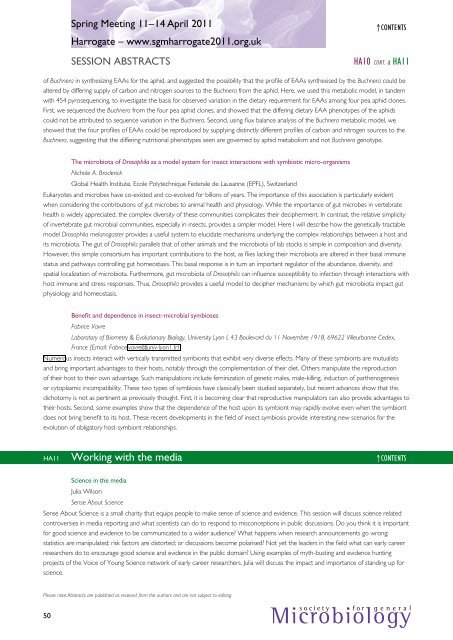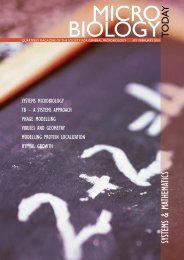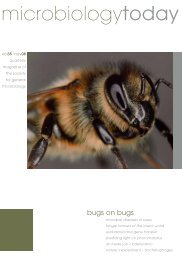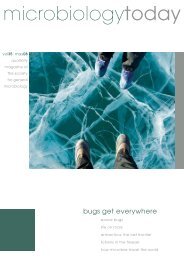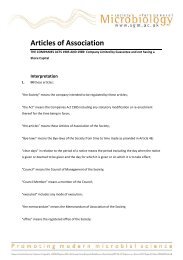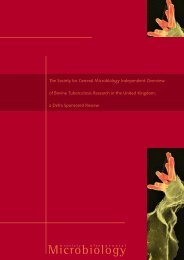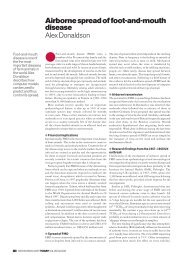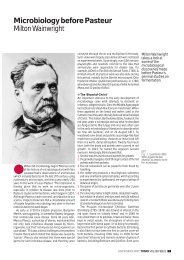Spring Conference 2011 - Society for General Microbiology
Spring Conference 2011 - Society for General Microbiology
Spring Conference 2011 - Society for General Microbiology
Create successful ePaper yourself
Turn your PDF publications into a flip-book with our unique Google optimized e-Paper software.
Please note: Abstracts are published as received from the authors and are not subject to editing.<br />
50<br />
<strong>Spring</strong> Meeting 11–14 April <strong>2011</strong><br />
Harrogate – www.sgmharrogate<strong>2011</strong>.org.uk<br />
SESSION AbSTrACTS<br />
↑Contents<br />
HA10 Cont. & HA11<br />
of Buchnera in synthesizing EAAs <strong>for</strong> the aphid, and suggested the possibility that the profile of EAAs synthesised by the Buchnera could be<br />
altered by differing supply of carbon and nitrogen sources to the Buchnera from the aphid. Here, we used this metabolic model, in tandem<br />
with 454 pyrosequencing, to investigate the basis <strong>for</strong> observed variation in the dietary requirement <strong>for</strong> EAAs among four pea aphid clones.<br />
First, we sequenced the Buchnera from the four pea aphid clones, and showed that the differing dietary EAA phenotypes of the aphids<br />
could not be attributed to sequence variation in the Buchnera. Second, using flux balance analysis of the Buchnera metabolic model, we<br />
showed that the four profiles of EAAs could be reproduced by supplying distinctly different profiles of carbon and nitrogen sources to the<br />
Buchnera, suggesting that the differing nutritional phenotypes seen are governed by aphid metabolism and not Buchnera genotype.<br />
The microbiota of Drosophila as a model system <strong>for</strong> insect interactions with symbiotic micro-organisms<br />
Nichole A. Broderick<br />
Global Health institute, Ecole Polytechnique Federale de lausanne (EPFl), Switzerland<br />
Eukaryotes and microbes have co-existed and co-evolved <strong>for</strong> billons of years. The importance of this association is particularly evident<br />
when considering the contributions of gut microbes to animal health and physiology. While the importance of gut microbes in vertebrate<br />
health is widely appreciated, the complex diversity of these communities complicates their decipherment. in contrast, the relative simplicity<br />
of invertebrate gut microbial communities, especially in insects, provides a simpler model. Here i will describe how the genetically tractable<br />
model Drosophila melanogaster provides a useful system to elucidate mechanisms underlying the complex relationships between a host and<br />
its microbiota. The gut of Drosophila parallels that of other animals and the microbiota of lab stocks is simple in composition and diversity.<br />
However, this simple consortium has important contributions to the host, as flies lacking their microbiota are altered in their basal immune<br />
status and pathways controlling gut homeostasis. This basal response is in turn an important regulator of the abundance, diversity, and<br />
spatial localization of microbiota. Furthermore, gut microbiota of Drosophila can influence susceptibility to infection through interactions with<br />
host immune and stress responses. Thus, Drosophila provides a useful model to decipher mechanisms by which gut microbiota impact gut<br />
physiology and homeostasis.<br />
benefit and dependence in insect–microbial symbioses<br />
Fabrice Vavre<br />
Laboratory of Biometry & Evolutionary Biology, University Lyon I, 43 Boulevard du 11 Novembre 1918, 69622 Villeurbanne Cedex,<br />
France (Email: Fabrice.vavre@univ-lyon1.fr)<br />
Numerous insects interact with vertically transmitted symbionts that exhibit very diverse effects. Many of these symbionts are mutualists<br />
and bring important advantages to their hosts, notably through the complementation of their diet. Others manipulate the reproduction<br />
of their host to their own advantage. Such manipulations include feminization of genetic males, male-killing, induction of parthenogenesis<br />
or cytoplasmic incompatibility. These two types of symbiosis have classically been studied separately, but recent advances show that this<br />
dichotomy is not as pertinent as previously thought. First, it is becoming clear that reproductive manipulators can also provide advantages to<br />
their hosts. Second, some examples show that the dependence of the host upon its symbiont may rapidly evolve even when the symbiont<br />
does not bring benefit to its host. These recent developments in the field of insect symbiosis provide interesting new scenarios <strong>for</strong> the<br />
evolution of obligatory host-symbiont relationships.<br />
HA11 Working with the media<br />
↑Contents<br />
Science in the media<br />
Julia Wilson<br />
Sense About Science<br />
Sense About Science is a small charity that equips people to make sense of science and evidence. This session will discuss science related<br />
controversies in media reporting and what scientists can do to respond to misconceptions in public discussions. Do you think it is important<br />
<strong>for</strong> good science and evidence to be communicated to a wider audience? What happens when research announcements go wrong;<br />
statistics are manipulated; risk factors are distorted; or discussions become polarised? Not yet the leaders in the field what can early career<br />
researchers do to encourage good science and evidence in the public domain? using examples of myth-busting and evidence hunting<br />
projects of the Voice of Young Science network of early career researchers, Julia will discuss the impact and importance of standing up <strong>for</strong><br />
science.<br />
s o c i e t y f o r g e n e r a l<br />
<strong>Microbiology</strong>


